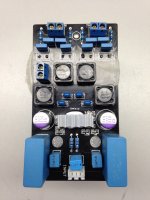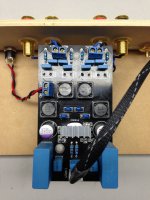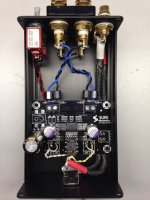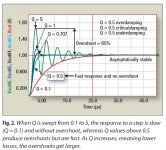Wow!! The price of the case is OK, it is the free shipping that makes it a good deal. I have been looking to buy some chasis for my F5 build for a while now. It is always the shipping charge that break the deals.
Please keep us posted on how the deal goes.
Regards,
So far they have responded on my messages, hence i asked if the power switch was included, which it was. Ive asked whether which potentiometer fits the hole optimally, and still waiting for response.
That is a good question. As I see it, the main function of a class D amplifier is nevertheless the A/D conversion, the amplification consists mainly of switching the output stage with enough current capability to drive the loudspeakers.Yes, my understanding is tubes have more 2nd order distortion whereas solid state has more 3rd order. If I recall odd order harmonic distortion is more damaging in sonic terms than 2nd order. Tubes do tend to have a greater amount of distortion than solid state even tho its the less damaging 2nd order.
I do not know where D class sits in all this. Unfortunately amplifier distortion is usually stated as THD (total harmonic distortion) which does not tell you the order where greater distortion lies.
For the A/D conversion there are several parameters which are to be taken into account: sampling rate, resolution, dynamic range. The distortion of the output signal is mainly related to the quantization errors. Depending of the A/D conversion type (the 3116 itself has 2 modes: BD modulation and 1SPW modulation) the distortion spectrum can have different harmonics.
One intersting thing related to minimisation of quantization errors is dithering, by adding a small noise to the input before conversion. I wonder if and how dithering could be used in the case of the 3116.
Other remark taken out from the 3116 datasheet: for good transient performance, the impedance seen at each of the two differential inputs should be the same. If the 3116 is driven by a single-ended source, then the unused input should see the same impedance as the used input. This is by far not the case in our application circuit.
That is a good question. As I see it, the main function of a class D amplifier is nevertheless the A/D conversion, the amplification consists mainly of switching the output stage with enough current capability to drive the loudspeakers.
For the A/D conversion there are several parameters which are to be taken into account: sampling rate, resolution, dynamic range. The distortion of the output signal is mainly related to the quantization errors. Depending of the A/D conversion type (the 3116 itself has 2 modes: BD modulation and 1SPW modulation) the distortion spectrum can have different harmonics.
One intersting thing related to minimisation of quantization errors is dithering, by adding a small noise to the input before conversion. I wonder if and how dithering could be used in the case of the 3116.
Other remark taken out from the 3116 datasheet: for good transient performance, the impedance seen at each of the two differential inputs should be the same. If the 3116 is driven by a single-ended source, then the unused input should see the same impedance as the used input. This is by far not the case in our application circuit.
I thought there was no A/D and D/A conversion here😕
there is pwm
fun wiki quote:
Another Sinclair Radionics product that was introduced in 1964 and failed was the first class D amplifier kit rated at 10 watt RMS. A class D switching amplifier that was good in theory but sadly ahead of its time and available technology. The amplifier used low frequency germanium transistors as pulse width modulators and switches and wrongly relied on the loudspeaker's inductance to filter the class D signal into audio. Most often this would short out the output transistors. When it did work the power level was far below 10 watts and Sinclair's main advertising channel, Wireless World Magazine, was so deluged with complaints that it supposedly refused to take further advertisements from Sinclair
Last edited:
You're right, there is PWM. No A/D conversion here, so my post is not useful, sorry.I thought there was no A/D and D/A conversion here😕
there is pwm
fun wiki quote:
Another Sinclair Radionics product that was introduced in 1964 and failed was the first class D amplifier kit rated at 10 watt RMS. A class D switching amplifier that was good in theory but sadly ahead of its time and available technology. The amplifier used low frequency germanium transistors as pulse width modulators and switches and wrongly relied on the loudspeaker's inductance to filter the class D signal into audio. Most often this would short out the output transistors. When it did work the power level was far below 10 watts and Sinclair's main advertising channel, Wireless World Magazine, was so deluged with complaints that it supposedly refused to take further advertisements from Sinclair
I need some help from the forum.
I have bought the TPA3116D2 BLU BOARD from Ebay.
What power adapter do you suggest to use? And what Volt and Ampere you suggest?
If compared to an IcePower or Abletec module this TPA3116 sound better, worse or identical?
Thanks
I have bought the TPA3116D2 BLU BOARD from Ebay.
What power adapter do you suggest to use? And what Volt and Ampere you suggest?
If compared to an IcePower or Abletec module this TPA3116 sound better, worse or identical?
Thanks
I need some help from the forum.
I have bought the TPA3116D2 BLU BOARD from Ebay.
What power adapter do you suggest to use? And what Volt and Ampere you suggest?
This question seems to come up every few pages, so I added a "Power Supply" section to The Wiki.
Hope that helps!
Thanks Very Very Much!
I have found all the information about the Voltage in the WikiGuide.
But Some indication about the Ampere required?
I have found all the information about the Voltage in the WikiGuide.
But Some indication about the Ampere required?
Last edited:
If compared to an IcePower or Abletec module this TPA3116 sound better, worse or identical?
Thanks
There are many Icepower boards and Abletec boards, Hypex too. Some will have load dependent frequency respons, some don't. This tpa3116 also has a load dependent frequency respons, like the 300asc from Icepower.
Meaning the amp 20-20khz frequency respons isn't a constant, with some speakers it will sound bright because high frequency rising, filter peaking, with others it can sound dull because overdamped high frequency filtering.
PBTL (Mono) Mode
(Please comment if the following mod will work and suggest any corrections.)
For the Black YJ board the following modifications are required:
- solder a three way jumper on the bottom of the board, shorting C10 and connected to the output side of C33
- jumper the ROUT terminals
- jumper the LOUT terminals
For the input use RIN and connect the speaker between ROUT and LOUT.
(Please comment if the following mod will work and suggest any corrections.)
For the Black YJ board the following modifications are required:
- solder a three way jumper on the bottom of the board, shorting C10 and connected to the output side of C33
- jumper the ROUT terminals
- jumper the LOUT terminals
For the input use RIN and connect the speaker between ROUT and LOUT.
There are many Icepower boards and Abletec boards, Hypex too. Some will have load dependent frequency respons, some don't. This tpa3116 also has a load dependent frequency respons, like the 300asc from Icepower.
Meaning the amp 20-20khz frequency respons isn't a constant, with some speakers it will sound bright because high frequency rising, filter peaking, with others it can sound dull because overdamped high frequency filtering.
Hi irribeo, I don't quite follow this, could you please explain? Does this mean the response varies with differing speaker characteristics? Specifically what characteristics, impedance curve?
looking at icepower 300 asc frequency respons again shows that it's far less loadimpedance dependent then tpa3116 btw, so probably also feedback controlled like hypex?
For TI an optimised 4 ohm outputfilter (Q=0.7) has 20khz well within -0.5dB, that same output filter used with a 6 ohm load has ~+2 dB at 20khz, filter peaks a little Q has become 1.2, underdamped. Same filter used with 16 ohm load impedance, many speakers have even higher 20khz impedance, will peak excessively, not all peaking will be within 20khz audioband. Impuls respons, transient respons can almost look undamped, an impuls could almost look like a sinewave continuing. I have added a random picture for transient respons, you can check filter calculator mentioned here befor and see if you can find corresponding values to use because it is a SE calculator 🙂 (your BTL 22uH,680nF, 8ohm load should show Q around 0.7)
For TI an optimised 4 ohm outputfilter (Q=0.7) has 20khz well within -0.5dB, that same output filter used with a 6 ohm load has ~+2 dB at 20khz, filter peaks a little Q has become 1.2, underdamped. Same filter used with 16 ohm load impedance, many speakers have even higher 20khz impedance, will peak excessively, not all peaking will be within 20khz audioband. Impuls respons, transient respons can almost look undamped, an impuls could almost look like a sinewave continuing. I have added a random picture for transient respons, you can check filter calculator mentioned here befor and see if you can find corresponding values to use because it is a SE calculator 🙂 (your BTL 22uH,680nF, 8ohm load should show Q around 0.7)
Attachments
In an earlier post, I mentioned that I was modifying a second Yuan Jing TPA3116 2.0 blue amp. To date, I installed:


After extensive listening, I can say these two mods have made significant improvements in terms of:


I used a strong magnet and found the TDK and Panasonic OSCON caps are non-magnetic. The leads appear to be Tinned Copper leads.
http://industrial.panasonic.com/ww/i_e/00000/id_oscon1309_e/id_oscon1309_e.pdf
Apparently, Panasonic's parent company Matsushita acquired Sanyo. These used to be sold as Sanyo OSCON capacitors.
My next mods on my TPA3116 amp will include:
- 4x TDK X7R 220nF/250V ceramic caps in bootstrap positions
- 2x Panasonic OSCON SEPF 330uF/25V organic semiconductor caps in power decoupling positions


After extensive listening, I can say these two mods have made significant improvements in terms of:
- Improved frequency response at both ends of the spectrum
- Clarity and smoothness with a very "fluid" and more detailed sound
- More natural tone and timbre
- Faster and more dynamic response with well defined attack and decay
- Better separation of performers in the soundstage


I used a strong magnet and found the TDK and Panasonic OSCON caps are non-magnetic. The leads appear to be Tinned Copper leads.
http://industrial.panasonic.com/ww/i_e/00000/id_oscon1309_e/id_oscon1309_e.pdf
Apparently, Panasonic's parent company Matsushita acquired Sanyo. These used to be sold as Sanyo OSCON capacitors.
My next mods on my TPA3116 amp will include:
- 4x Coilcraft SER2915L 10uH shielded inductors
- 4x Wima MKP10 3.3uF/160V metallized Polypropylene film caps (NOS)
Where did you get that sweet case?
The case is Part No. 3008 from Context Engineering based in San Jose, California:
Split Body Enclosures available from Context Engineering
The case's footprint is just slightly wider than my iPhone 5. The knob is a machined Aluminum knob that can be purchased from Mouser, Digikey or a number of China-based eBay sellers. The 3 in. wide Sure Electronics TPA3110 amp board slides right into the internal card slots in the case.
rhing regarding the bootstrap caps: what value did the removed bootstrap caps have? (I think this part of mod is only to bring blueboard back to TI adviced value)
rhing regarding the bootstrap caps: what value did the removed bootstrap caps have? (I think this part of mod is only to bring blueboard back to TI adviced value)
It was the same value -- 220nF, only the YJ stock caps were blue metallized
Polyester film caps.
ok, thought wushuliu then maybe had different values, some blueboard had different bootstrap values I seem to remember🙂
don dapkus,d2 as in typenumber of these chips, answered several times on TI forum that if cost is no object caps for beter SQ should be metal film except close to chip HF decoupling. Ceramics are adviced for cost motive.
edit: I believe Saturnus adviced x7r ceramics with 10 times max voltage rating, at least 4 times. maybe then equal or better
edit2: hybrid panasonics high frequencies I believe I had same idea as you wrote about the oscons, low frequency I believe were weaker, but I didn't listen long enough, the hybrids are currently powering LCD tv speakers🙂 socalled burn-in LOL
My PBTL boards have 220uF silmics for 1 week now, powered until today by one 12.5v 6A Indeed brick, low frequencies were absent, added second powerbrick again today and yes, 6A for 2 boards is too little even for moderate levels, bass drive back now, don't think yet 220uF silmics are equal to 680uF FM in bass however, but close. Need to listen more serious.
don dapkus,d2 as in typenumber of these chips, answered several times on TI forum that if cost is no object caps for beter SQ should be metal film except close to chip HF decoupling. Ceramics are adviced for cost motive.
edit: I believe Saturnus adviced x7r ceramics with 10 times max voltage rating, at least 4 times. maybe then equal or better
edit2: hybrid panasonics high frequencies I believe I had same idea as you wrote about the oscons, low frequency I believe were weaker, but I didn't listen long enough, the hybrids are currently powering LCD tv speakers🙂 socalled burn-in LOL
My PBTL boards have 220uF silmics for 1 week now, powered until today by one 12.5v 6A Indeed brick, low frequencies were absent, added second powerbrick again today and yes, 6A for 2 boards is too little even for moderate levels, bass drive back now, don't think yet 220uF silmics are equal to 680uF FM in bass however, but close. Need to listen more serious.
Last edited:
It was the same value -- 220nF, only the YJ stock caps were blue metallized
Polyester film caps.
My YJ black had original uiJ100 (100nF) cap for the bootstrap cap, not 220nF, should I change to 220nF ?
- Home
- Amplifiers
- Class D
- TPA3116D2 Amp
